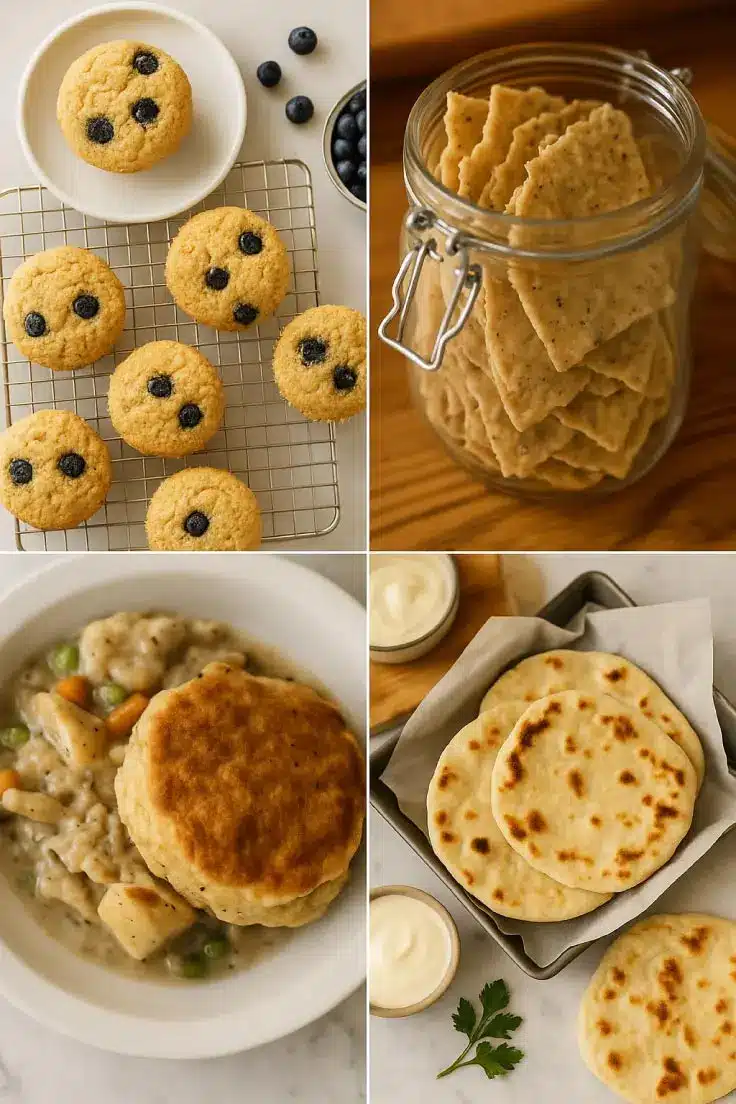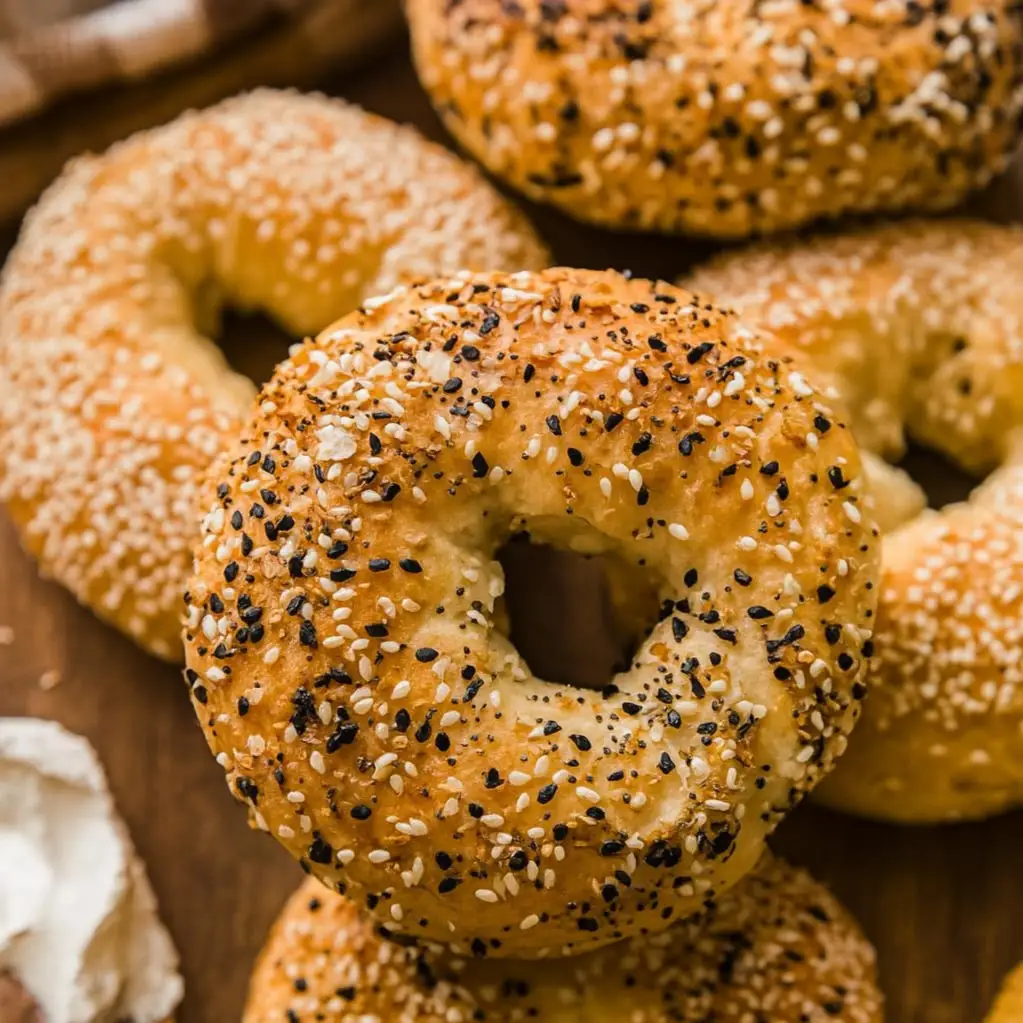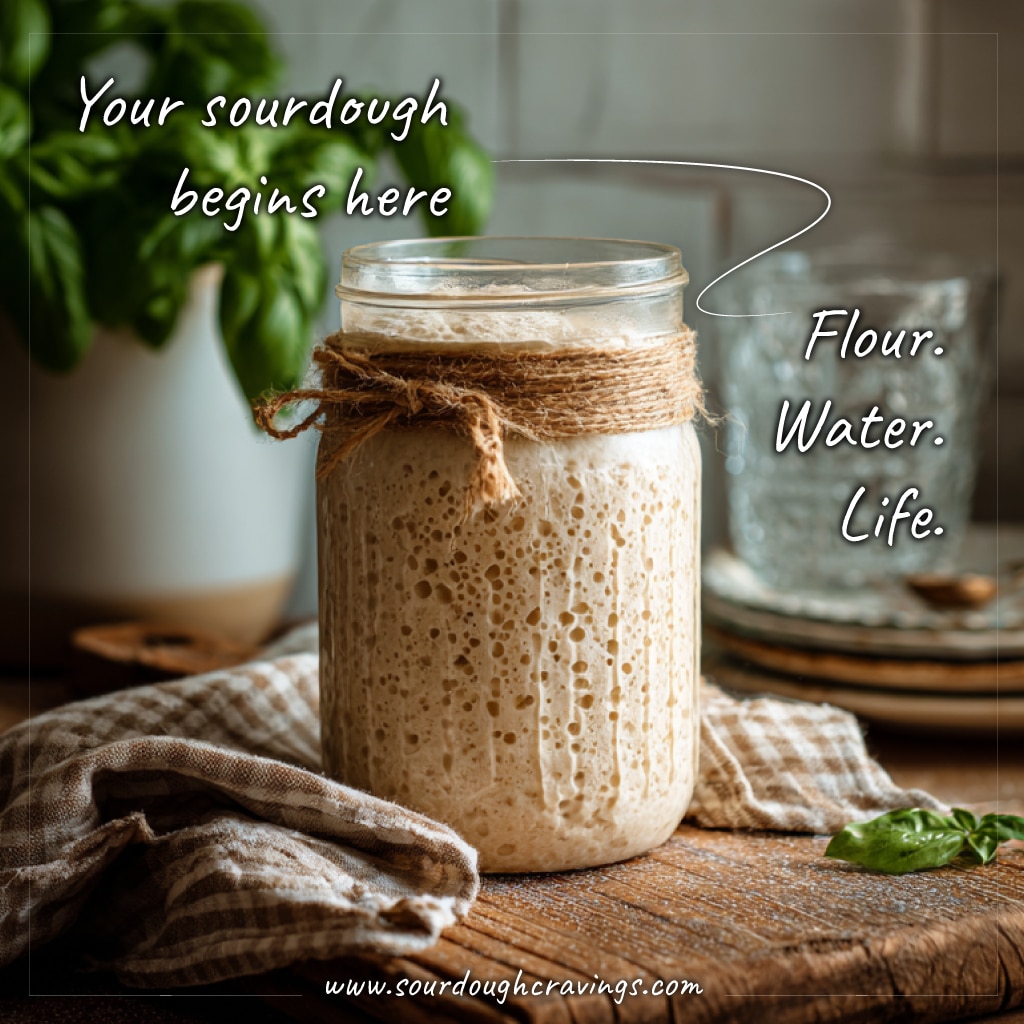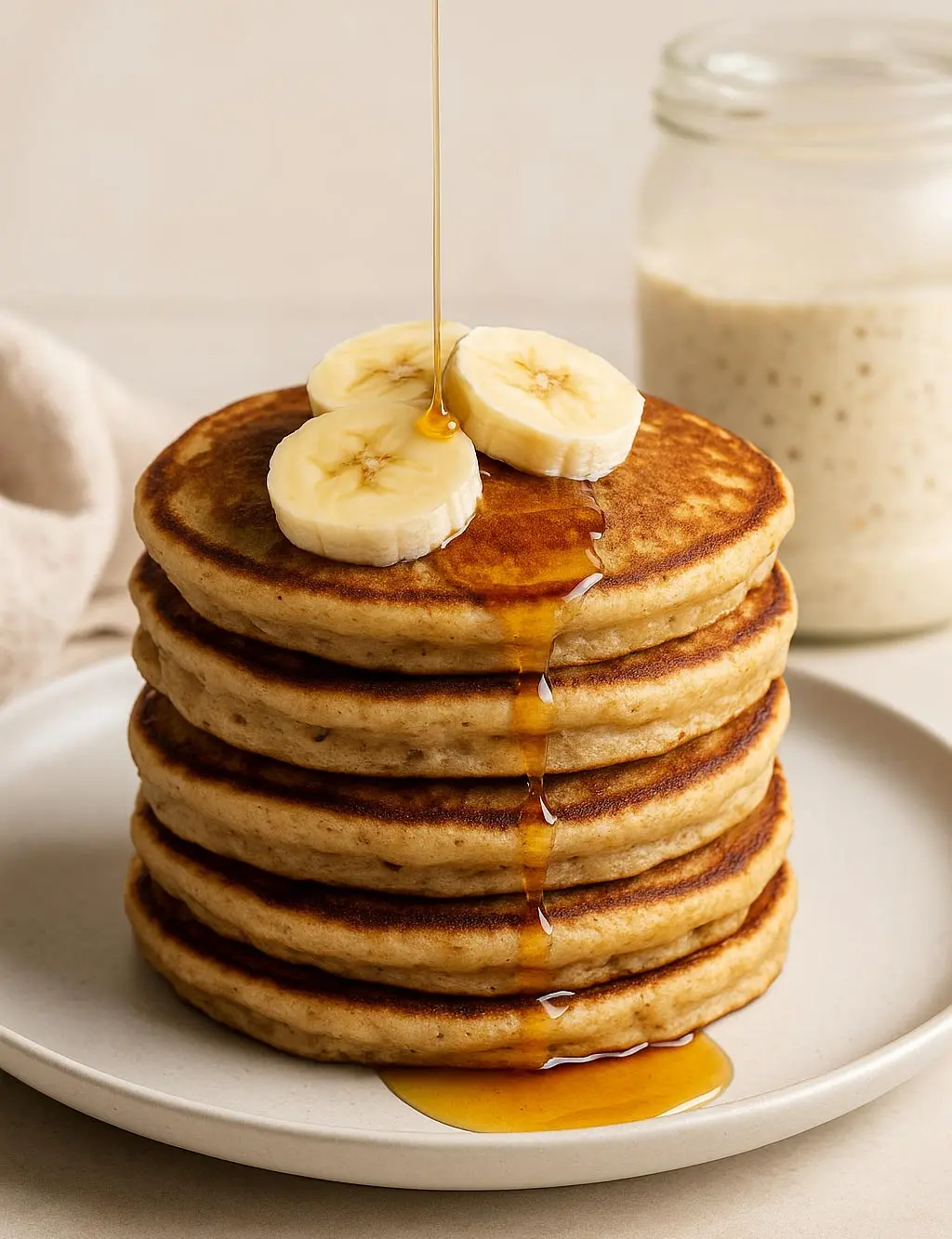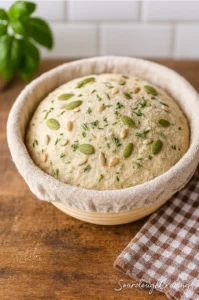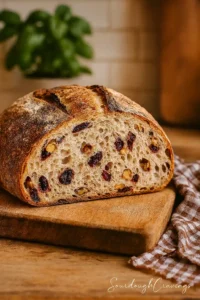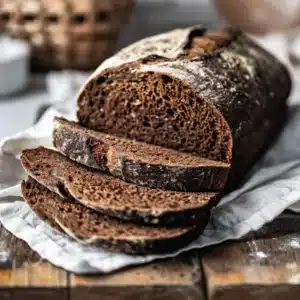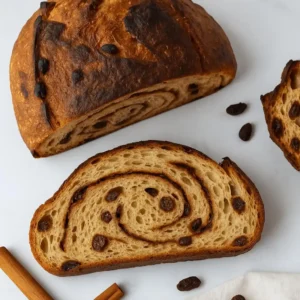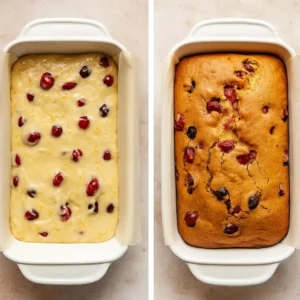It all started with a forgotten head of garlic on the back of my stove.
I had just baked a plain loaf and spotted the roasted cloves from the night before—still warm, soft, and full of that sweet, earthy aroma. I couldn’t resist folding them into my dough the next day with a sprinkle of dried rosemary. That was the first time I tasted garlic herb sourdough, and it changed everything.
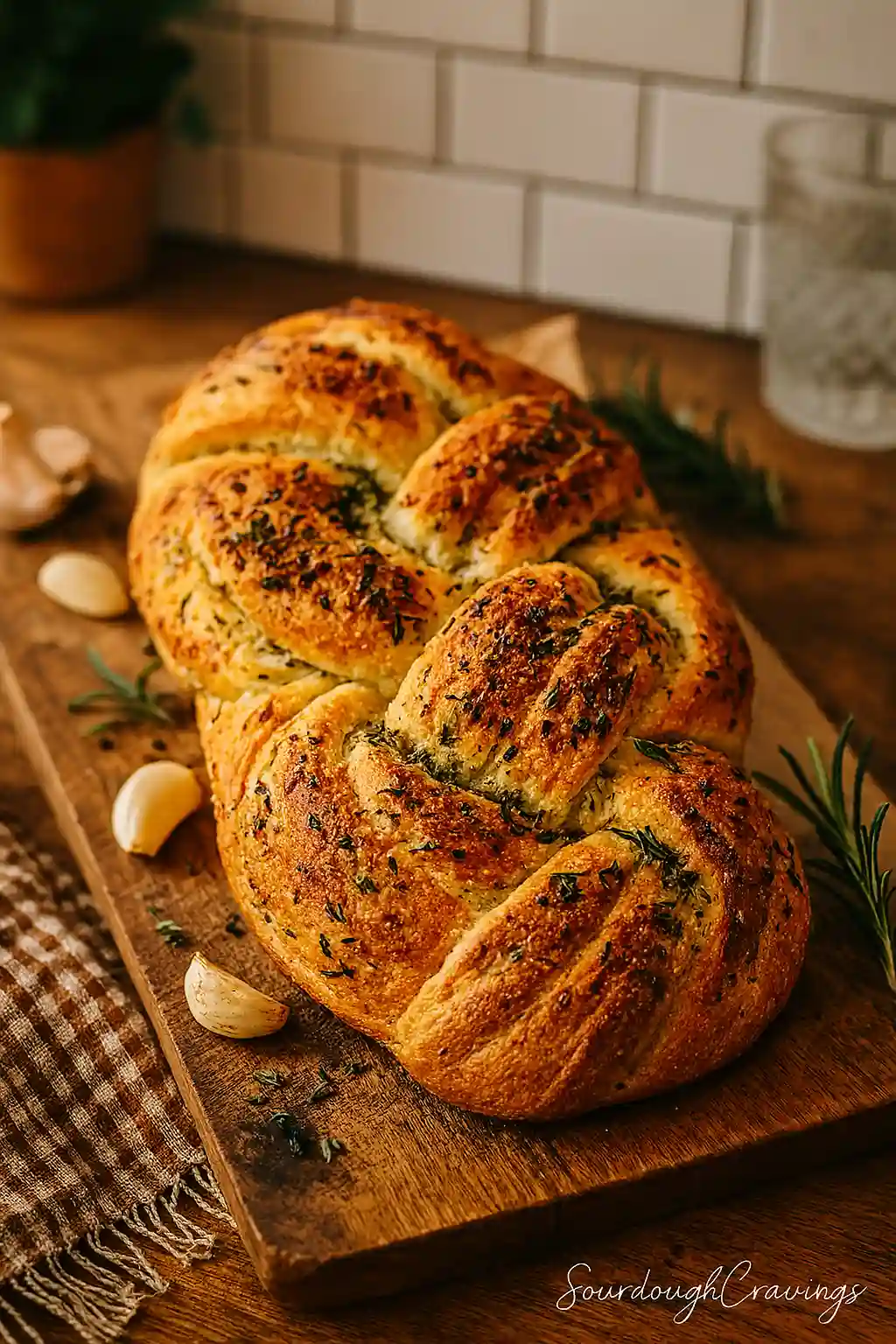
What I love about garlic herb sourdough is how customizable it is. You can use raw garlic for bite, roasted for richness, or even garlic powder when you’re in a pinch. Add fresh thyme, chives, or sage—whatever’s in season or on your windowsill. It’s a recipe that feels rustic and elegant all at once, with a crust that crackles and a crumb that smells like heaven.
If you’re looking to experiment with savory loaves, this one absolutely belongs in your Savory Inclusions Guide. You’ll learn when to mix in your garlic and herbs, how much to use, and how to make sure that flavorful crust doesn’t burn.
Once you bake your first garlic herb sourdough, I promise—it won’t be your last.

Garlic Herb Sourdough
Ingredients
Method
- 1. Feed your starter 4–6 hours before mixing if it’s been refrigerated.

- 2. Mix flour and water and let autolyse for 45–60 minutes.
- 3. Add starter and salt, mix thoroughly with stretch and fold.
- 4. Let rest 30 minutes.
- 5. Lamination: Gently stretch the dough and layer in roasted garlic and herbs. Fold into thirds.

- 6. Bulk ferment for 4–5 hours at 70°F, performing 3–4 stretch and folds every 30 minutes.
- 7. Pre-shape dough and bench rest for 20 minutes uncovered.
- 8. Final shape and place into floured banneton. Cold proof overnight (10–16 hrs).
- 9. Bake at 475°F in Dutch oven: 20 mins covered, 22 mins uncovered.
- 10. Cool completely before slicing.

Nutrition
Notes
Loved this recipe?
Leave a rating & comment. how it was!Table of Content
What Makes Garlic Herb Sourdough So Irresistible?
There’s just something about garlic herb sourdough that makes it vanish from the cutting board before dinner even starts. Maybe it’s the way roasted garlic caramelizes into sweet little pockets inside the loaf. Or how the herbs—whether you use rosemary, thyme, or even basil—release their oils right into the dough as it bakes. Every slice feels like a warm hug with a crispy, golden edge.
But it’s more than just flavor. Garlic herb sourdough hits that rare combo of comforting and elevated. It’s perfect for Sunday brunch, dipping into soup, or making sandwiches that feel gourmet without the effort. And trust me, once you’ve baked a loaf that smells like fresh garlic knots and toasted sourdough? Your kitchen will never be the same.
The Flavor Trio: Tangy, Garlicky, and Aromatic
Sourdough’s natural tang gives the perfect contrast to rich garlic and earthy herbs. I like using a mix—roasted garlic for mellow sweetness, and dried thyme or rosemary for those bright, piney notes. What makes garlic herb sourdough stand out is how it balances bold ingredients without overpowering the dough’s natural complexity.
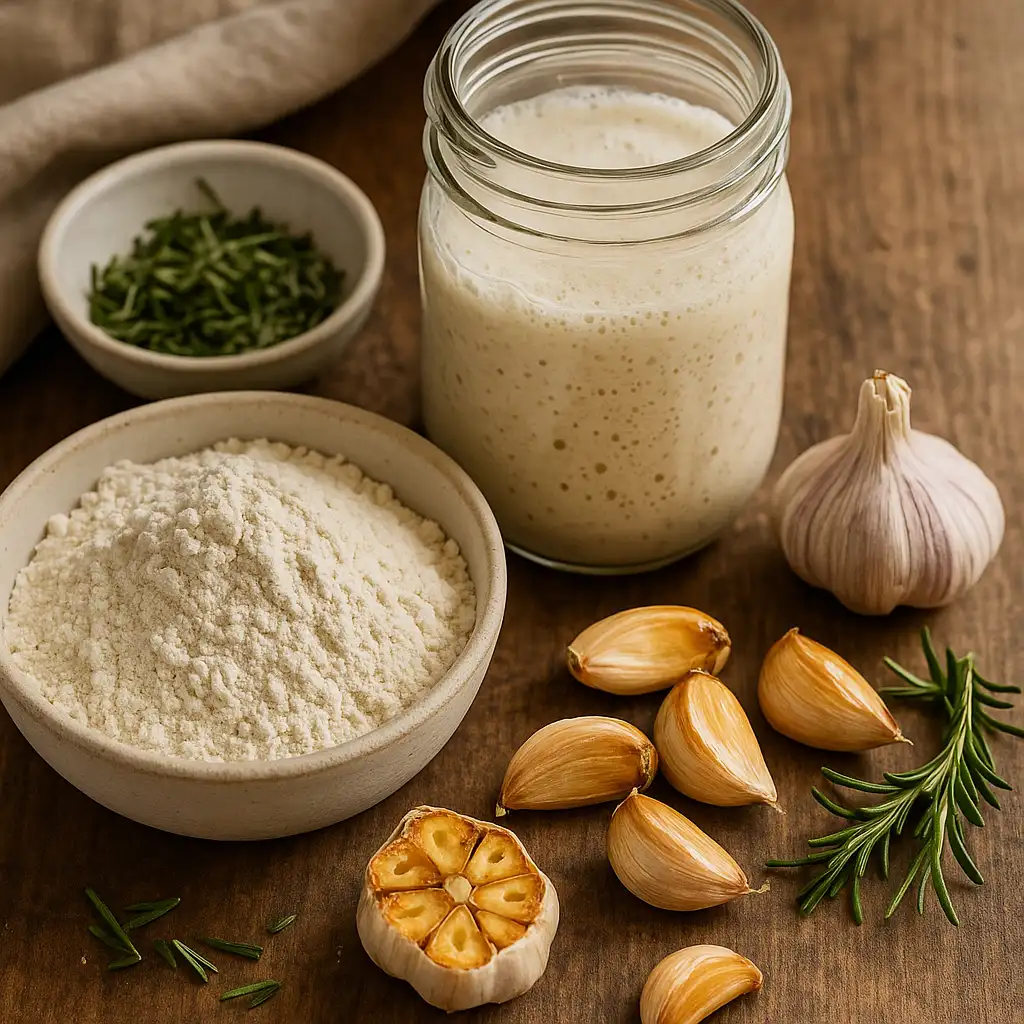
The key? Let your inclusions complement—not compete with—the sour flavor.
Why Herbs Act Differently in Sourdough Than in Focaccia
In focaccia, herbs and garlic often sit on top, crisping in oil. But with garlic herb sourdough, they’re folded in and exposed to long fermentation. That means flavor develops from the inside out—and it changes depending on whether you use fresh, dried, or roasted ingredients.
If you’re curious how that compares to other spice-forward loaves, check out my take on Everything Bagel Sourdough—another favorite in my savory lineup.
How to Choose the Right Garlic and Herbs: Fresh, Roasted, or Dried?
If you’ve ever made garlic herb sourdough and ended up with bitter, burnt garlic or bland, barely-there flavor—you’re not alone. The key to nailing flavor lies in picking the right type of garlic and herbs—and knowing exactly when to fold them in.
Over the years, I’ve experimented with everything from whole roasted cloves to dried minced garlic and even a garlic confit (spoiler: amazing but messy). Each one brings something unique to your garlic herb sourdough, and knowing the differences will help you nail the flavor every time.
When to Use Roasted Garlic vs. Raw Garlic
Roasted garlic infuses the sourdough crumb with gentle sweetness, softening the flavor without any of the raw bite. It’s perfect when you want your garlic herb sourdough to be mellow and slightly sweet—especially in loaves paired with soups or mild cheeses.
Fresh garlic, on the other hand, is punchy. It’ll hold its shape and flavor more firmly and is best used in small amounts or pre-cooked in oil. I always mince it fine, then sauté gently to tame the harshness before folding it in.
Best Herbs to Use (and How to Add Them)
When it comes to herbs, less is more. Dried herbs (like thyme, rosemary, or oregano) are more concentrated and need time to rehydrate in the dough. Fresh herbs (like chives or basil) are brighter but can wilt or brown during baking.
For most garlic herb sourdough recipes, I recommend:
- 1 tbsp chopped fresh herbs
- or 1 tsp dried herbs per 500g flour
Want more flavor without overdoing it? Try infusing olive oil with garlic and herbs, then brushing it on before baking. It won’t overpower the dough and makes the crust extra fragrant.
If you’ve never roasted garlic before, The Kitchn has a super handy guide that walks you through it. It’s foolproof.
| Type | Flavor Profile | Best Use in Sourdough |
|---|---|---|
| Roasted Garlic | Sweet, mellow, spreadable | Fold into crumb or swirl into laminated dough |
| Fresh Garlic | Pungent, sharp, intense | Cook lightly before adding or use sparingly |
| Dried Garlic | Mild, nutty, slightly bitter when overused | Add early to bulk ferment so it hydrates properly |
📌 Garlic types and how they behave in garlic herb sourdough
How to Mix Garlic & Herbs Into Sourdough (Without Overpowering It)
The first time I folded garlic and herbs into my dough, I thought “more is better,” right? Wrong. I ended up with soggy pockets of garlic, torn gluten, and a loaf that tasted more like stuffing than sourdough. It turns out, making perfect garlic herb sourdough is all about balance—and timing.
Folding & Lamination: When to Add Garlic and Herbs
For soft or roasted garlic, I prefer the lamination method. Following the first fold, I spread out the dough, add the garlic and herbs evenly, then fold it like an envelope to keep the mix-ins well distributed. This keeps the inclusions evenly spread without tearing the dough structure.
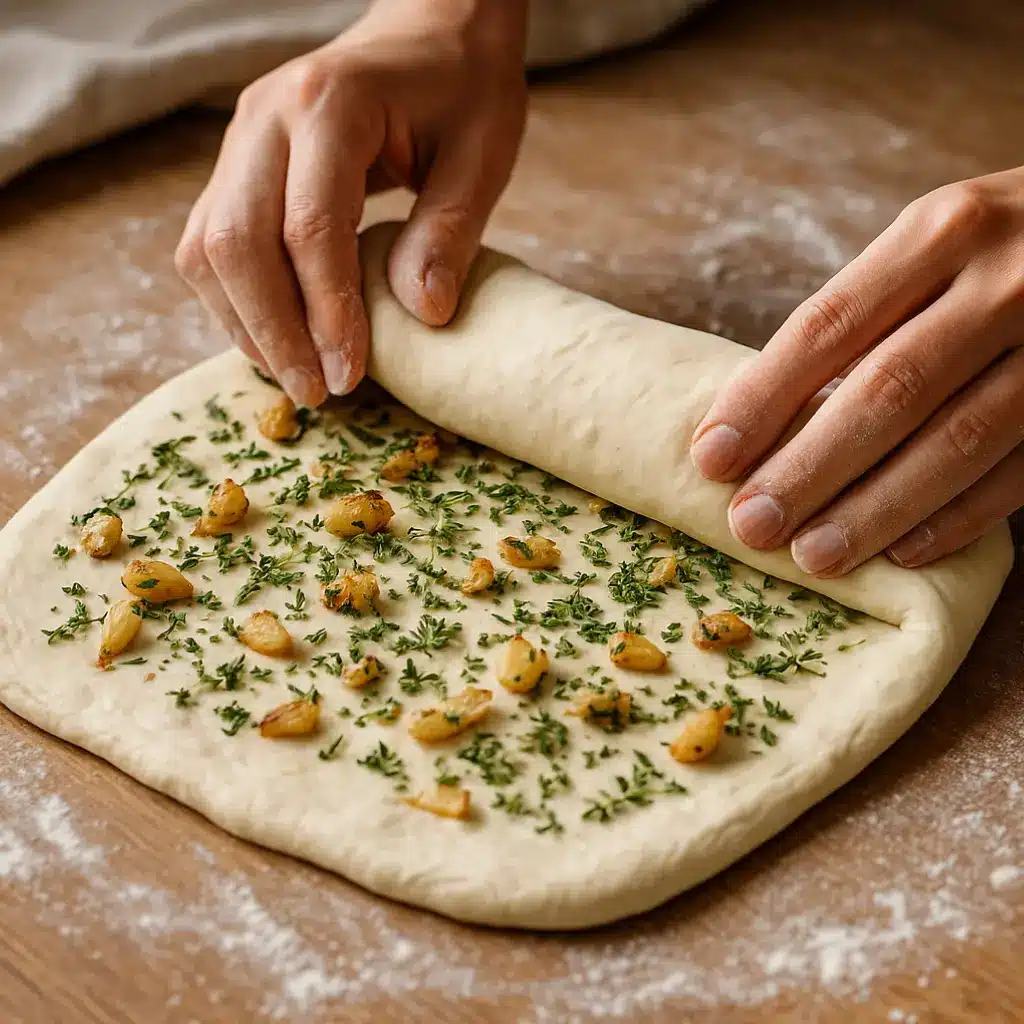
If I’m using dried herbs, I sometimes add them at the start of bulk fermentation. That gives them time to hydrate and mellow out. Just avoid adding garlic too early—it can interfere with fermentation if it’s strong or acidic.
A good rule of thumb for garlic herb sourdough:
- Herbs = early or mid-bulk
- Garlic = during lamination or final folds
Interactive: How Much Garlic and Herbs to Add?
- Roasted garlic: 20–30g (about 1–2 cloves)
- Fresh garlic (lightly sautéed): 10–15g (1 small clove)
- Dried garlic: 1–2 tsp
- Fresh herbs: 1 tbsp finely chopped (rosemary, chives, thyme)
- Dried herbs: 1 tsp
📌 Always mix herbs evenly to avoid bitter pockets and keep dough from tearing.
📌 Garlic and herb ratios for garlic herb sourdough
The beauty of garlic herb sourdough is how customizable it is—once you know the guidelines. You can start small and build up, adjusting to your taste with each bake. The more loaves you make, the more intuitive it becomes.
Just like any good relationship, garlic and herbs need the right timing to shine.
Step-by-Step: Garlic Herb Sourdough Recipe Walkthrough
There’s no better way to master garlic herb sourdough than to bake it side-by-side with a guide that walks you through every step—timing, texture, inclusions, and all. I’ve broken down the process I use at home into an easy two-day flow, so even busy bakers (hi, fellow moms!) can enjoy a loaf full of bold, balanced flavor.
Sample Bake Schedule for Garlic Herb Sourdough
This schedule is designed for a room temp of 70–72°F. Adjust slightly warmer or cooler depending on your kitchen.
| Step | Time | Notes |
|---|---|---|
| Feed Starter | 7:00 AM | Use a 1:2:2 ratio if starter was refrigerated |
| Mix Dough + Autolyse | 11:00 AM | Mix flour & water first, then rest 45–60 mins |
| Add Starter + Salt | 12:00 PM | Pinch and fold until fully incorporated |
| Add Garlic & Herbs (Lamination) | 1:00 PM | Sprinkle during dough stretch |
| Bulk Fermentation | 1:00–5:00 PM | 3–4 sets of stretch & folds, 30 mins apart |
| Pre-shape & Bench Rest | 5:15 PM | Rest 15–20 mins uncovered |
| Final Shape & Cold Proof | 6:00 PM | Refrigerate overnight (10–16 hours) |
| Bake | Next Day – 8:00 AM | Score + bake at 475°F (20 covered, 22–25 uncovered) |
📌 Garlic herb sourdough 2-day baking schedule
Topping Tips: How to Prevent Garlic From Burning
If you like sprinkling minced garlic or dried herbs on the surface of your garlic herb sourdough, here’s a little trick: mist the loaf with water or olive oil before adding the toppings. This helps them adhere and protects them from scorching in the oven.
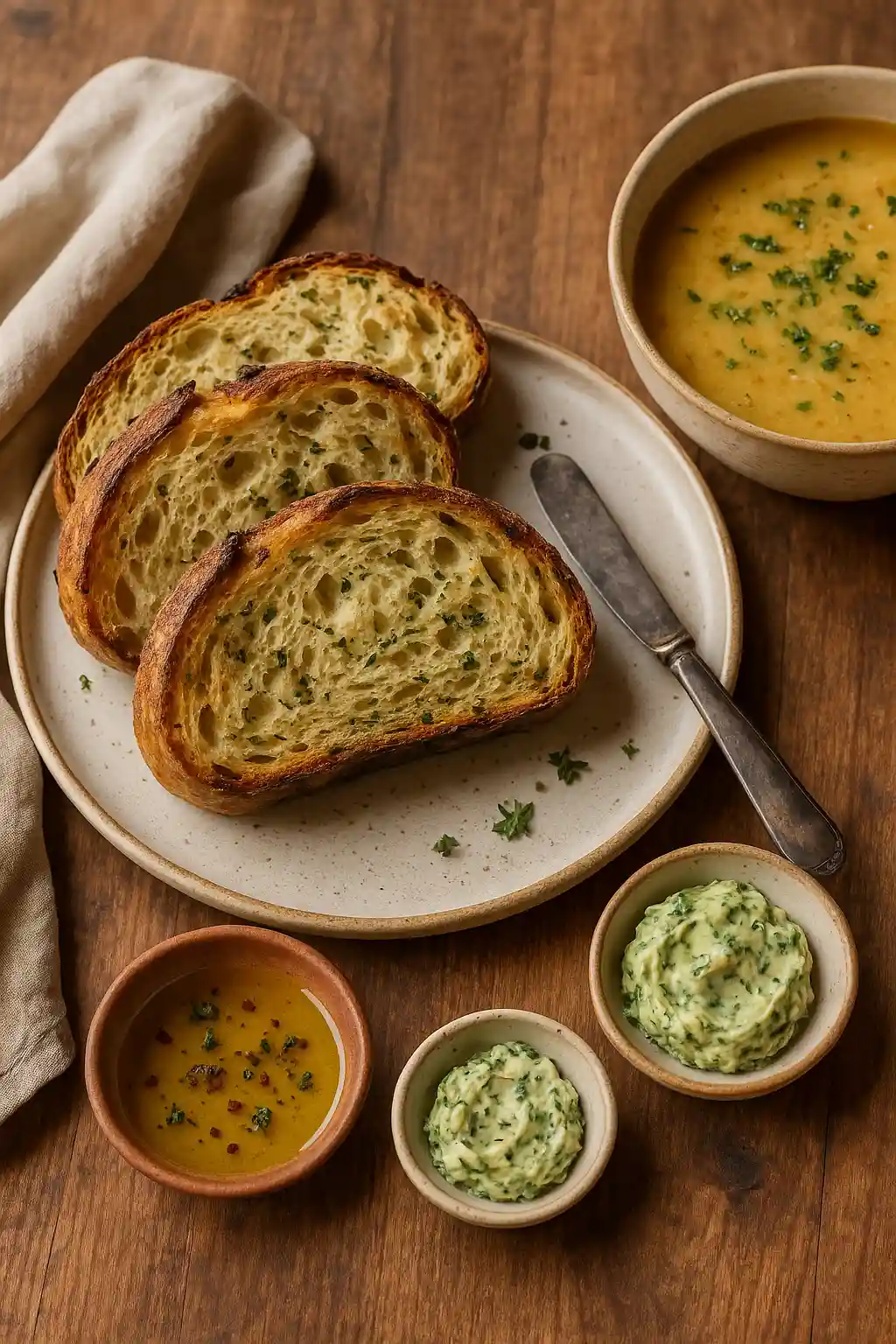
You can also tent the loaf with foil for the final 10 minutes of baking if your oven runs hot or you’re using lots of garlic in the crust. Burnt garlic is bitter—and it doesn’t do justice to that beautiful sourdough flavor underneath.
Serving Ideas + Storage Tips for Garlic Herb Sourdough
By the time my garlic herb sourdough comes out of the oven, the smell alone has my whole household hovering in the kitchen. It’s the kind of loaf that doesn’t just sit pretty on a breadboard—it’s meant to be shared, torn, dipped, and devoured. Whether you’re serving it with a hearty fall stew or a light herb butter in spring, this savory loaf fits just about every table.
Best Ways to Serve Garlic Herb Sourdough
Garlic herb sourdough is incredibly versatile. It pairs beautifully with creamy spreads, bold cheeses, and anything that welcomes a punch of flavor. Here are some of my favorite combos from the test kitchen (a.k.a. my crowded countertop):
| Pairing | Perfect With… |
|---|---|
| Toasted Slices | Soft goat cheese + roasted red peppers |
| Grilled Cheese | Aged cheddar + tomato soup |
| Dipping | Olive oil + balsamic + cracked pepper |
| Sandwiches | Turkey + provolone + arugula + mustard |
📌 Garlic herb sourdough pairing ideas for every season
Pair your garlic herb sourdough with a bold spread like roasted garlic butter, or dip it straight into tomato basil soup—it soaks up flavor like a dream.
Storage Tips to Keep It Fresh & Fragrant
The oils in garlic and herbs can cause sourdough to spoil more quickly if not stored properly. Here’s how I keep my garlic herb sourdough tasting as fresh on day three as it was out of the oven:
- Cool completely before storing—trapped steam = soggy crust.
- Wrap in a linen or paper bag for 24–48 hours on the counter.
- For longer storage, slice and freeze in parchment stacks inside a zip bag.
- Warm it up in a 350°F oven for 8 to 10 minutes to bring back that fresh-from-the-oven scent.
Whatever you do—don’t put it in the fridge! Cold air stales bread faster than you can say “starter.”
FAQs About Garlic Herb Sourdough
When it comes to baking garlic herb sourdough, even experienced bakers run into questions. Between ingredient timing, flavor balance, and baking technique, there’s plenty of room for nuance (and, let’s be honest, a few “learning loaves” too). I’ve pulled together the most common questions I’ve received—from DMs to sourdough class Q&As—so you can bake with confidence.
Can you put fresh garlic in sourdough bread?
Yes, but with care! Fresh garlic is powerful and can affect fermentation if added too early. For garlic herb sourdough, it’s best to lightly sauté or roast fresh garlic before folding it into your dough during the lamination or second fold. This keeps the flavor mellow and the crumb smooth, not harsh or gummy.
How can you keep garlic from burning when baking sourdough?
Burnt garlic is one of the fastest ways to ruin a good loaf. To protect your garlic herb sourdough, avoid placing raw garlic pieces near the crust or surface unless they’ve been fully roasted. You can also mist your loaf with water or brush with olive oil before baking to shield surface toppings from direct heat. Tent with foil for the last 10 minutes if needed.
Can I use garlic powder or dried herbs in sourdough?
Absolutely! Garlic powder and dried herbs are great options for convenience or winter baking when fresh herbs aren’t available. Just remember: dried ingredients are more concentrated. In garlic herb sourdough, I recommend 1 tsp of garlic powder and 1 tsp of dried herbs per 500g of flour. Rehydrate them slightly during bulk fermentation if possible.
How much garlic and herbs should I add to my sourdough?
It depends on the type of garlic and herb. Here’s a quick refresher (also featured earlier in the post):
Roasted garlic: 20–30g
Fresh garlic (sautéed): 10–15g
Dried garlic: 1–2 tsp
Fresh herbs: 1 tbsp
Dried herbs: 1 tsp
This balance lets your garlic herb sourdough shine without overpowering the natural tang of the dough
Final Thoughts on Garlic Herb Sourdough
If you ask me what loaf I bake most often for dinner parties and family potlucks, it’s always garlic herb sourdough. It checks every box—bold, earthy, and crowd-pleasing with just enough rustic charm to impress without trying too hard.
Whether you’re just starting to play with savory mix-ins or you’ve already nailed down your signature swirl, garlic herb sourdough offers endless room to experiment. You can learn how to pair it with other savory favorites in my Best Sourdough Inclusions Guide, where I dive deeper into all the flavor combos I’ve tested over the years.
And if you’re craving something with a little spice kick, I’d definitely suggest giving Everything Bagel Sourdough a go next—it’s another favorite in the Seeded & Spiced category, and it makes the best toast on the planet.
For anyone wanting to understand how garlic behaves in long ferments or how herbs impact hydration, I highly recommend King Arthur Baking’s sourdough tips—it’s one of my go-to sources for baking science done right.
In the end, every garlic herb sourdough loaf you make becomes a reflection of your preferences, your pantry, and your patience. And once your kitchen starts smelling like roasted garlic and thyme… don’t say I didn’t warn you. Your neighbors might come knocking.




